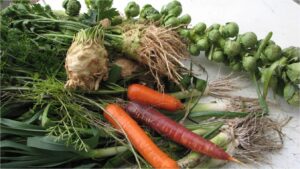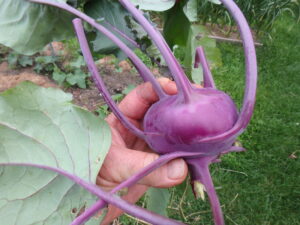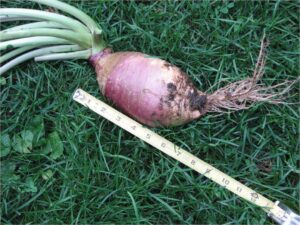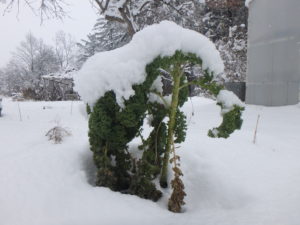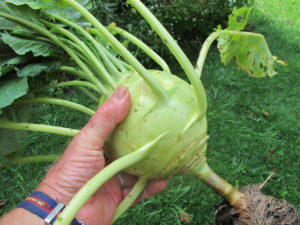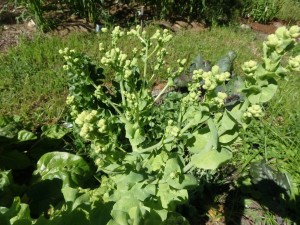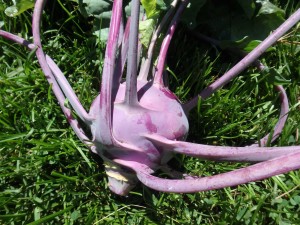Six Less Common Veggies You Might Like
One of my favorites is celeriac, or celery root. This is a close cousin to celery, but less attractive to slugs and snails, and easier to grow. It is a funny looking root crop with many fat roots. It tastes very much like celery in a soup or stew, though it is not usually eaten raw. I peel the roots, and chop the round bulb into chunks for cooking. If stored in the vegetable drawer or a cold cellar with high humidity and cool temperatures, it will store all winter.
Kohlrabi germinates in less than a week and grows fast. Although you can start them indoors, you don’t need to. In most places you can start them now. Plant seeds outdoors 3 to 4 inches apart and thin every other one if all grow. They like consistently moist soil, so add compost at planting time.
Rutabagas are also relatives of kale and broccoli, members of the Brassica family. I plant them by seed in June, and thin to 8 inches as these are big root crops that will not produce well if crowded. Although flea beetles can bother them, I’ve never had anything eat mine. Cover with row covers if you have a problem.
Eating From the Garden Every Day of the Year
For breakfast I often drink a green smoothie that includes a banana, kale, some OJ, half a lime, fresh ginger, fresh mint if I have it, and water. It’s healthy, tasty, and uses kale I grew. I usually pick fresh ‘Winterbor’ kale from my garden until mid-December as even temperatures in the 20’s don’t seem to bother it. But all winter I have bags of frozen kale I can chop and add to my morning drinks – and winter stews.
Having a spare freezer – or more than one – is a wonderful way to keep eating from the garden all year. Here’s what I have in mine right now: tomatoes, peppers, green beans, broccoli, kale, strawberries, blueberries, leeks, apples for pies, peaches, applesauce and plum puree.
Tomatoes dominate the freezer. I freeze them whole, skins on, and make sauce or use them the way I would canned tomatoes. The skins come off easily – I just drop them into a pan of hot tap water for a couple of minutes, then rub the skins off. Of course you can leave the skins on, if you want.
I also have homemade tomato sauce in the freezer, complete with onions, garlic, basil, oregano and other herbs. And then there are the bags of tomato paste I cook down from tomatoes that I cut up, puree in a blender, and boil down till very thick. I freeze the paste in ice cube trays, then transfer the cubes to zipper bags when frozen.
Freezing does take some work. I blanch kale, beets, broccoli, squash and green beans before I freeze them. That means I drop them in boiling water for a minute or so, put them in cold water, and then dry them well before freezing. The quick boiling kills the enzymes that cause aging, making for a better product. I don’t blanch tomatoes, peppers, fruit or leeks. But for best results it is good to eat those in year one, not year four or five.
The easiest way to keep food for eating all winter is to store it in a cool location. I have a cold basement and a cool area in the entry area of my house. Potatoes, carrots, kohlrabi and rutabagas store well in the basement with high humidity and temperatures in the 33 to 50 degree range.
When I have lots of root crops I store them in a cement block bin with a plywood lid. The bin is big enough for six 5-gallon pails. It keeps out the mice, holds in the humidity, and keeps the vegetables at a relatively constant temperature. I keep an indoor-outdoor thermometer sensor in it, so I can monitor the temperature from upstairs. If it gets too cold, I plug in an electric heat mat I also use for starting seedlings. I put a little moist sand in the bottom of each bucket to help with the humidity.
Other veggies need low humidity and cool temperatures. Those include onions, shallots, garlic and winter squash. I keep them on a wooden rack I got from Gardeners Supply, their “orchard rack”. I have that in the main part of the house where I have a woodstove – hence low humidity. But I keep them near the mudroom, which is unheated, so they stay cool. You can also keep squash under the bed upstairs in a spare bedroom with the heat off and the door closed.
Lastly, I dehydrate cherry tomatoes, hot peppers and apples. I find the drying process tends to concentrate flavors. I cut the cherry tomatoes in half, set the thermostat at 130 degrees, and bag them up when dry, but not brittle. Hot peppers I dry till brittle, and then grind them in my coffee grinder. That way I can add just a little zing to a dish, and avoid hot chunks. I grind the pepper seeds, too.
So here is a good winter stew made from my own veggies. You can add a pound of sausage or stew beef to this or leave it as a vegetarian dish. I do it both ways. If you use meat, brown it first in oil, then drain any excess oil and add the veggies.
Chop 2 yellow onions coarsely and brown in a cast iron pot. Then add the root vegetables according to what you have and what you like: 5 medium carrots cut in rounds (about 2 cups), 1 cup rutabaga cut in ½ inch cubes, 1 cup kohlrabi peeled and cut in ½ inch cubes, ½ to 1 cup celeriac, finely chopped. If you have no celeriac, substitute celery, they are relatives with the same flavor. Potatoes will go in the stew at the end, as they tend to fall apart if cooked too long.
Next add 5 frozen tomatoes, skinned and coarsely chopped. If you don’t have your own, add a 28 oz. can of crushed tomatoes, preferably organic. Add 3 to 4 cups water or broth, and perhaps a cup of apple cider. Add 1 to 2 cups chopped kale if you like kale. Simmer.
Garlic tends to burn easily if added with the onions, so add it after the liquid to avoid that. Use 1 to 3 cloves garlic, crushed or chopped fine.
Next add herbs, according to your supply – and your taste. I have frozen parsley, and chop a couple of tablespoons of it. I add fresh rosemary from a plant on the window sill, a nice sprig chopped fine. A tablespoon of Herbs de Provence from the Coop is good, too. Then I add some ground hot pepper to add some zing. Simmer.
Lastly I add 2 cups potatoes cut in ½ inch cubes that have been boiled for 10 minutes in a separate pot. Drain, and add to the stew. Simmer another 10 minutes and serve. Enjoy!
Henry is the author of 4 gardening books and has been a UNH Master Gardener for over 20 years.
Going to Seed … or the Freezer
My vegetable garden is producing more food each day than I can eat, but I’m trying to keep up with it by freezing, dehydrating and storing the bounty. And of course, I drive around with zucchini in my car, always looking for a willing recipient of some summer squash. But I am also deliberately letting some things go to seed.
We sometimes describe people who are going downhill and not paying attention to their appearances as “going to seed.” That’s an odd phrase, and has negative connotations. But I like letting lettuces and some other greens go to seed. Why? They will come back and produce early greens in the garden.
Once lettuce starts to elongate and get tall, also known as bolting, it starts to get bitter. If you pick it, you will notice white sap in the stem, usually a sign of bitter alkaloids. So you can pull it and toss it on the compost pile, or allow it to produce seed. Or eat it, if you like the flavor.
Most lettuces are not hybrids, so you can save their seed and get good free seeds. But read the seed package or catalog – or go on line and ask Dr. Google – to verify that the named variety you are growing is not a hybrid before collecting seed, or allowing it to self-sow. Anything listed as “heirloom” not a hybrid. (Hybrids are crosses of two varieties and do not usually breed true).
Lettuce normally self-pollinates as the stigma (which captures the male pollen) pushes up through the florets. If you want to cross breed lettuces, I have read that you can grow different varieties side-by-side and then tie two plants together when they have bolted and are about to produce flowers, thus facilitating cross breeding. I’ve never tried this, however.
If I want lettuce to produce seeds, I remove any newspapers and hay – the mulch I use – from around it. This allows seeds to fall freely into the soil where it will, generally, not germinate until next spring. Alternatively, one can take plants with dry seeds and shake the seeds out over a new, clean bed for lettuce next year.
I like to let a few other greens go to seed, too. Magenta spreen, amaranth and orach are other edible greens that I grow – but rarely have to plant. All are just one step from being weeds, and can be eaten raw or cooked. Orach has gorgeous purple leaves, and the spreen, particularly when young, has green leaves with pink edges. Amaranth has edible leaves, nice blossoms, and seeds that are eaten as grain in South America. Right now I have one spike of magenta spreen that stands 104 inches tall!
Tomatoes are starting to ripen for me: first the cherries, and now smaller plum tomatoes. In a few weeks those big, juicy heirloom tomatoes like Brandywine will be along – sending me, temporarily at least, to heaven.
I had a garden party recently and my guests were somewhat surprised to see that I have 30-some tomato plants. Although I share some of the fruit, I eat it fresh (3 times a day) and freeze the rest. I freeze whole tomatoes in zipper bags and cook with them all year.
To make these “red rocks”, all I do is wipe them clean and fit them into freezer-grade plastic bags. I place them on a cookie sheet in the freezer. When I want to make a soup or stew that calls for tomatoes, I just run a few tomatoes under hot water in the sink until I can easily rub off the skins. Then I wait a few minutes for them to soften, and cut into pieces for the soup pot.
Imperfect tomatoes I often make into tomato paste and freeze in ice cube trays until frozen, and then in zipper bags. I remove any imperfect spots and then core the tomatoes in the sink, squeeze out the excess seeds and juice, and puree in the Cuisinart. Then I boil down the puree for a few hours in a heavy enamel-clad cast iron pot. When I can literally stand up a spoon in the mix, it’s done. I leave it out all night uncovered to cool and to evaporate a little more moisture before spooning it into those ice cube trays.
Kohlrabi has done very well for me this year. I started seeds in the house in the spring, and transplanted them into the gardening early summer. This worked better than planting seeds in the ground, as there was no thinning to be done and the plants are perfectly placed.
I peel raw kohlrabi and cut it up in salads, or cook it in stir-fry or stews. The purple variety I’m eating now is so pretty I’m going to use it as a centerpiece on the table tonight. Oh my, the pleasure I get from my garden!
Read Henry’s blog twice weekly at https://dailyuv.com/
Late Summer Plantings in the Vegetable Garden
If you are like me, you have some space in your vegetable garden now. I have pulled all my garlic and my peas. Or maybe you planted a big patch of lettuce early on, and it’s been eaten or gone by. In any event, you could slow down and just mulch your empty beds, or you could plant more veggies for the fall.
One of my favorite items to plant now is a fall radish called ‘Red Meat’. It is also sometimes called the watermelon radish or Beauty Heart radish. It has white skin with green shoulders and a red and white interior. You probably will not find seeds for this radish at your local garden center or hardware store, you will have to order it from a seed company. I have gotten my seeds from Johnny’s Selected Seeds in Maine, and see that is available from Kitazawa Seeds of Oakland, CA and Baker Creek Heirloom Seeds. All three companies are excellent.
Here is what is special about the watermelon radish: it grows to 4 inches in diameter without getting tough or woody. And you can only plant it in late summer, as it will bolt if you plant it in the spring.
It is fabulous added to a green salad, or made with into a salad with sweet onions and tomatoes and dressed with a vinaigrette sauce. And like all radishes, it is fast growing. Order now, plant by Labor Day, and enjoy them throughout the fall. Johnny’s catalog lists them as 50 days to maturity. Which means you can start eating the smaller ones in half that! I plant them 2 inches apart, then thin to 4 inches apart, eating the small thinnings. Unlike stronger-tasting radishes, you don’t have to be macho to pull and eat this radish straight from the garden. Yum!
Lettuce, of course is a good fall crop. I like to start lettuce seeds in those small plastic 6-packs left over from spring. I fill them with a good planting mix and lay seeds right on the soil surface, then cover with just a hint of soil mix or vermiculite. Lettuce, planted too deeply, will not germinate well. It needs light to trigger germination, just like many weeds. But that means you need to water regularly to keep the seeds from drying out.
By planting seeds in 6-packs with potting soil it is easier to separate the seedlings from each other than if you planted directly in the ground. I like to plant lettuce 6 inches apart in the garden so that each plant will develop into a nice head. Or if the roots are too tangled, maybe 2 or 3 seedlings can be planted as a clump without problems. Some gardeners like to sow lettuce seeds thickly in the garden, and then cut the leaves when small, particularly if using salad mixes. According to the Johnny’s catalog, which I know is accurate, lettuce germinates poorly in temperature over 75 degrees. So if we have a hot spell, start them in flats in a cool place indoors.
Kohrabi is another great veggie, one sadly unknown to many gardeners. It is in the Brassica or broccoli family, and develops a globe-shaped edible stem above ground with leaves emerging from the edible part. People often say, though I don’t know why, it “looks like a space alien.” It comes in purple and green-skinned varieties.
But here’s the great part: certain varieties of kohlrabi reach maturity in as little as 37 days! That said, read the catalog carefully: some storage kohlrabi like ‘Kossak’ can take 80 days to mature and get to be 8 inches or more in diameter. Most varieties should be eaten between 2 and 4 inches in diameter. Direct seed and thin to 4 inches.
Mostly I eat kohlrabi as a coleslaw. I use the grating blade on my food processor (it’s a flat grater blade up top on an extension, not the regular chopping/cutting blade in the bottom of the bowl). That makes quick work of the grating, which I used to do by hand. I mix it 50-50 with grated carrots and add a vinaigrette sauce, fennel seeds and dried cranberries or raisins. Kohlrabi can also be added to a stir fry or stews.
Daphne, my “killer corgi” normally keeps the deer away. No, I do not tie her up in the garden at night. Her very presence each day lets deer know that it is not a good idea to intrude, and generally they do not. But one night this summer a deer came in and ate all the leaves off my beets! The nerve! So I will plant some more beets for fall eating.
Beets are fairly frost hardy and mature in about 7 weeks from planting. So I should have a nice crop of small to medium sized beets in October if I plant now. According to Johnny’s catalog, the “scab” that sometimes appears on beets (raised brown rough spots) can be prevented by keeping beets well irrigated. A fall planting will most likely get plenty or rain, and produce some nice looking beets. The scab does not harm the beets – I just remove it with a potato peeler.
I haven’t even gotten around to putting up my hammock and might not this year! If you’ve been industrious all summer – weeding, thinning, watering and more, you’ve earned some time off. But I find I always want to push the limits, so I ordered more seeds and planed a few things for late fall.
Henry is a gardening consultant and the author of 4 gardening books. His website is www.Gardening-Guy.com.



